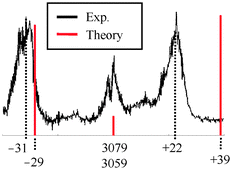Vibrational quasi-degenerate perturbation theory: applications to fermi resonance in CO2, H2CO, and C6H6†
Abstract
A quasi-degenerate perturbation method with vibrational self-consistent field (VSCF) reference wavefunction is developed. It simultaneously accounts for strong anharmonic mode–mode coupling among a few states (static correlation) by a configuration interaction theory and for weak coupling with a vast number of the other states (dynamic correlation) by a perturbation theory. A general formula is derived based on the van Vleck perturbation theory. An algorithm that selects a compact set of the most important VSCF configurations which contribute to the static correlation is proposed and a scheme to limit the number of configurations considered for dynamic correlation is also implemented. This method reproduces the vibrational frequencies of CO2 and H2CO that are subject to the strongest anharmonic mode–mode coupling within 10 cm−1 of vibrational configuration interaction results in a computational expense reduced by a factor of one to two orders of magnitude. The method also reproduces the infrared absorption of C6H6 in the CH stretching (ν12) frequency region, in which combination tones ν13ν16 and ν2ν13ν18 appear on account of an intensity borrowing from ν12via the anharmonic coupling.


 Please wait while we load your content...
Please wait while we load your content...